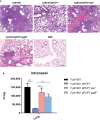PgtE Enzyme of Salmonella enterica Shares the Similar Biological Roles to Plasminogen Activator (Pla) in Interacting With DEC-205 (CD205), and Enhancing Host Dissemination and Infectivity by Yersinia pestis
- PMID: 35401532
- PMCID: PMC8986990
- DOI: 10.3389/fimmu.2022.791799
PgtE Enzyme of Salmonella enterica Shares the Similar Biological Roles to Plasminogen Activator (Pla) in Interacting With DEC-205 (CD205), and Enhancing Host Dissemination and Infectivity by Yersinia pestis
Abstract
Yersinia pestis, the cause of plague, is a newly evolved Gram-negative bacterium. Through the acquisition of the plasminogen activator (Pla), Y. pestis gained the means to rapidly disseminate throughout its mammalian hosts. It was suggested that Y. pestis utilizes Pla to interact with the DEC-205 (CD205) receptor on antigen-presenting cells (APCs) to initiate host dissemination and infection. However, the evolutionary origin of Pla has not been fully elucidated. The PgtE enzyme of Salmonella enterica, involved in host dissemination, shows sequence similarity with the Y. pestis Pla. In this study, we demonstrated that both Escherichia coli K-12 and Y. pestis bacteria expressing the PgtE-protein were able to interact with primary alveolar macrophages and DEC-205-transfected CHO cells. The interaction between PgtE-expressing bacteria and DEC-205-expressing transfectants could be inhibited by the application of an anti-DEC-205 antibody. Moreover, PgtE-expressing Y. pestis partially re-gained the ability to promote host dissemination and infection. In conclusion, the DEC-205-PgtE interaction plays a role in promoting the dissemination and infection of Y. pestis, suggesting that Pla and the PgtE of S. enterica might share a common evolutionary origin.
Keywords: DEC-205 (CD205); PgtE; Salmonella enterica; Yersinia pestis; dissemination; evolution.
Copyright © 2022 Li, Ye, Zhao, Li, Zhu, Lv, Park, Zhang, Jiang, Yang, He, Cai, Zhang, Ding, Njiri, Tembo, Alkraiem, Li, Sun, Li, Yan, Kan, Huo, Klena, Skurnik, Anisimov, Gao, Han, Yang, Xiamu, Wang, Chen, Chai, Sun, Yuan and Chen.
Conflict of interest statement
CP was employed by Genuv Inc. The remaining authors declare that the research was conducted in the absence of any commercial or financial relationships that could be construed as a potential conflict of interest.
Figures





Similar articles
-
Plasminogen activator Pla of Yersinia pestis utilizes murine DEC-205 (CD205) as a receptor to promote dissemination.J Biol Chem. 2008 Nov 14;283(46):31511-21. doi: 10.1074/jbc.M804646200. Epub 2008 Jul 23. J Biol Chem. 2008. PMID: 18650418 Free PMC article.
-
Lack of O-antigen is essential for plasminogen activation by Yersinia pestis and Salmonella enterica.Mol Microbiol. 2004 Jan;51(1):215-25. doi: 10.1046/j.1365-2958.2003.03817.x. Mol Microbiol. 2004. PMID: 14651623
-
Thrombin-activatable fibrinolysis inhibitor is degraded by Salmonella enterica and Yersinia pestis.J Thromb Haemost. 2010 Oct;8(10):2232-40. doi: 10.1111/j.1538-7836.2010.04014.x. J Thromb Haemost. 2010. PMID: 20704647
-
Fibrinolytic and procoagulant activities of Yersinia pestis and Salmonella enterica.J Thromb Haemost. 2015 Jun;13 Suppl 1:S115-20. doi: 10.1111/jth.12932. J Thromb Haemost. 2015. PMID: 26149012 Review.
-
The omptin family of enterobacterial surface proteases/adhesins: from housekeeping in Escherichia coli to systemic spread of Yersinia pestis.Int J Med Microbiol. 2004 Jul;294(1):7-14. doi: 10.1016/j.ijmm.2004.01.003. Int J Med Microbiol. 2004. PMID: 15293449 Review.
References
MeSH terms
Substances
LinkOut - more resources
Full Text Sources
Research Materials
Miscellaneous

